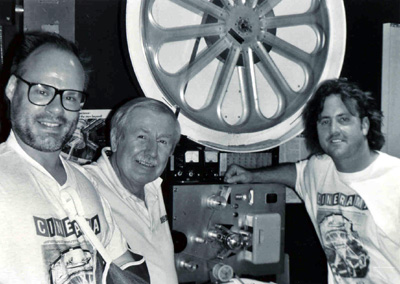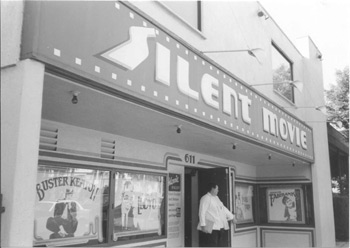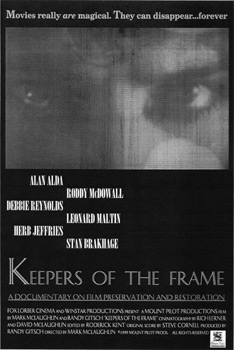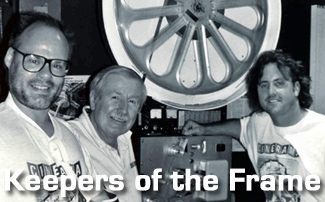 Cinerama
in your house! If you're John Harvey, why not. Harvey, a life-long
projectionist and Cinerama enthusiast, leads you through his
converted home theatre in Mount Pilot's production's documentary on
film preservation and restoration, "Keepers of the Frame". Harvey
stands with the films' producers, Randy Gitsch, and director Mark
McLaughlin. Cinerama
in your house! If you're John Harvey, why not. Harvey, a life-long
projectionist and Cinerama enthusiast, leads you through his
converted home theatre in Mount Pilot's production's documentary on
film preservation and restoration, "Keepers of the Frame". Harvey
stands with the films' producers, Randy Gitsch, and director Mark
McLaughlin.
Photo Copyright 1999 Mount Pilot Productions.
Early in 1996 Mark McLaughlin and
Randy Gitsch began making the film you are
about to see. There were at that time archives, organizations and
individuals raising their collective voices to champion film preservation as
a cause and an important one. We wanted to bring the subject into a wider
public consciousness, and to raise awareness as to the fragile state of the
most important document of the 20th Century, the motion picture.
One of our
first interviews was with the late Laurence Austin, of the now closed
Silent Movie theatre in Los Angeles. Mark was compelled to capture this
unique theater, which was for years the only weekly-scheduled, silent movie
venue in America, and to tell the story of it's founder, John Hampton, who
as a collector, had persevered to preserve and screen silent films when they
were out of style and largely discarded. Laurence Austin continued what
John Hampton had started, by sharing silent cinema (along with live organ
accompaniment) with contemporary audiences, thus reminding them of the
importance of saving these films.
Laurence Austin was tragically murdered
just a few months later, during an evenings' program in that theater. A
voice of preservation was silenced that night, but in Laurence Austin's
death, we as filmmakers were reinforced in our desire to inspire others, in
the way that he had inspired us, to see, enjoy and respect the cinema of the
other-than mainstream.
We hope your respect for filmed imagery, and
appreciation for its' preservation, may grow after viewing “Keepers of the
Frame”.
|
What you'll see in “Keepers of the Frame”
|
 The
now shuttered Silent Movie theatre in Los Angeles, USA, has been closed
since the tragic murder therein of owner/host Laurence Austin. Austin
eloquently discusses the need to preserve silent motion pictures in Mount
Pilot Productions' documentary on film preservation and restoration,
"Keepers of the Frame". Photo Copyright 1999 Mount Pilot Productions.
*) = see sidebar The
now shuttered Silent Movie theatre in Los Angeles, USA, has been closed
since the tragic murder therein of owner/host Laurence Austin. Austin
eloquently discusses the need to preserve silent motion pictures in Mount
Pilot Productions' documentary on film preservation and restoration,
"Keepers of the Frame". Photo Copyright 1999 Mount Pilot Productions.
*) = see sidebar
Think of your favourite movie... A film that you identify with, attach a
memory to, or one that has motivated you in some way. How would you feel if
you found out that it no longer existed? You would never be able to watch it
at a revival theater, rent it on video or share it with anyone. More
importantly, no one in the future would be able to see it, be entertained by
it, or learn from it.
Our recent history has been clearly defined because of the advent of movies,
newsreels, documentaries and all types of films. The ideals, style and
culture of the 20th century are resting on celluloid. But everyday, some
part of that legacy is lost as our motion pictures turn to dust before we
can preserve them. Nearly 90% of all silent films and nearly 50% of sound
pictures made before 1950 have been lost. Problems continue as "vinegar
syndrome" and color fading attack our beloved contemporary classics.
“Keepers of the Frame” is the first filmed documentary to examine
with depth, the history, science and struggles of those committed to film
preservation. It witnesses artists and technicians passionately preserving
our filmed heritage. Their story is an adventure, rife with discoveries of
lost treasures.
However, “Keepers of the Frame” is more than a technical explanation
of how films deteriorate and how they are restored. It brings to light the
damage done not only to our Hollywood film heritage, but also the plight of
special collections and film genres never before discussed in the
preservation context. These include such important and varied filmed works
as newsreels, black cast films, experimental and avant-garde films,
ethnographic film studies, "Soundies" musical performances and even home
movies. Our documentary imparts the importance of all kinds of films, the
education they provide and the enchantment they create.
“Keepers of the Frame” has a logical, linear structure to examine and
discuss its major concepts;
|
Capturing Time
As portable cameras were invented, cinematographers were soon roaming the
world. The films of this early era are the very first moving records of our
history, providing glimpses into a living past. Early motion pictures had no
ensuing life after short theatrical runs and they were largely discarded.
Ninety percent of the films from this era are now gone.
Killing Time
Early storage problems caused tragic nitrate film explosions and fires,
resulting in lost films and lost lives. “Keepers of the Frame” explains how
film deteriorates through nitrate decomposition, vinegar syndrome, color
fading and warping. It also reveals how soundtracks have been lost through
the deterioration of magnetic film elements, as well as by the breaking and
loss of sound on discs.
Saving Time
Restoration experts passionately piece together picture and sound elements
from all over the world. “Keepers of the Frame” will witness the detective
work, the surprising discoveries, and the science and technologies that go
into preservation.
Buying time
“Keepers of the Frame” examines the optimistic outlook of preservation with
proper storage in underground salt mines and in state-of-the-art facilities.
It also explores significant archives, major studio vaults and special film
collections.
Cherishing Time
People make old films live again. “Keepers of the Frame” hears from
film collectors, noteworthy filmmakers and movie stars exuberant about film
and its survival.
and Timeless Moments
You will see the "last pass" possible through a printer of a significant,
badly decomposing film. As attending technicians try to impede its loss, the
film falls apart before your eyes.
Many individuals, not only entertainment
personalities, but educators, historians and scientists reached out in
allowing Mount Pilot Productions to interview them, to film inside their
workplaces and homes. They wanted this documentary to be made, their story
to be told, and attention paid to this important subject.
Film preservation and restoration is vital to our future. People living
hundreds or thousands of years from now will be able to look at us and
understand their own history in a way that we can only imagine. Those who
see “Keepers of the Frame” will be inspired by a greater understanding of
the twentieth century's culture and art as uniquely reflected through the
motion picture.
|
Some of the very special visuals in “Keepers of the Frame”
|
Mount Pilot Productions is proud to bring to the screen many very rare and
very precious films and sound clips in “Keepers of the Frame”. Many of these
clips have never before been seen or heard, and many others may sadly, never
be again. Included among these clips are;
The oldest film in the holdings of the Library of Congress: Edison's
“Imperial Japanese Dance” (1894) - as deteriorated.
The oldest surviving complete american feature-length film “Richard III” (1912) starring Frederick Warde.
From the only known existent film print “Cinerama Holiday" (1955) a 3-panel
Cinerama-process motion picture that has faded entirely to shades of pink.
Restored 3-strip Technicolor feature films “A Star is Born” (1937-restored
by UCLA - before and after restoration sequences shown) starring Janet Gaynor
& Fredric March.
Rematched to Vitaphone sound disc restorations “Evangeline” (1929-rematched
and now in the full restoration by UCLA) starring Dolores Del Rio.
Vitaphone discs for which the matching film no longer exists ”Theater Opening” (1928) starring Al Jolson.
Never before seen ethnographic films “Yupik eskimo life, St. Lawrence
Island, Alaska" (1930) photographed by the late ethnocinematographer Henry
Col!ins for the Smithsonian Institution. Never before seen or used in any other
documentary compilation.
Never before seen news films “Famed outlaws, Clyde Barrow and Bonnie Parker
met death in Gibsland, LA" (1934) Never before seen or used in Any other
documentary compiration.
Seldom seen avantgarde films, black-cast pictures, "soundies" musical
Performances and pre-1911 "paper print" films.
And also brought to our audience...Still photos, ad art & reviews of films
that no longer exist "Cleopatra" (1917) starring Theda Bara,
“Lone Glorlous
Day" (1922) starring Will Rogers, "Beau Sabreur" (1928) starring
Gary Cooper
|
The FAQ:
|
What is "film preservation"?
Basically, film preservation is proper storage...storage of film elements,
film negatives and prints, under the optimal conditions, low temperatures
and low humidity. But at a larger, more timelier level, film preservation is the
restoration of a film. That restoration can involve the duplication of
films, the composition of images from different copies of films to make one
best copy, sound track re-recording, digital enhancement and a whole lot
more.
How did you become interested in film preservation?
Director, Mark Mclaughlin:
When I was 12, I saw a print of the 1933 classic, "King Kong", which
contained scenes that were originally excised from the film 's U.S. release
because the Hays office thought they were graphically violent or sexual. In
one of the scenes, Kong slowly peels the clothes off Fay Wray like she's a
banana. The new scenes fascinated me, especially that one I guess. But they
also made me aware of the history and the process of making one of my
favourite movies at that time. So I had an interest in the search for rare
film from an early age. About ten years ago. I was in a lab in Denver and I
walked past a room where a couple of people were carefully cleaning an old
nitrate negative. They explained the process of restoring these films to me.
But what really excited me was the fact that they had in their hands, the
original camera negatives to a very early Disney silent cartoon. It amazed
me that significant pieces of film history were being cared for by small
groups of technicians, and that if they didn’t make this effort, the
films would probably just disappear forever. ,
Producer Randy Gitsch:
I once worked with a collection of nitrate newsreels and regularly would go
into the vault to retrieve the film for a particular news story. All too
frequency, I'd pull a metal film can out of its' rack, only to have the film
fall right out of the bottom of the can through a hole it had created as it
deteriorated. I then had to regularly throw away precious news films of the
events of WWI, of Women's Suffragettes marching, Presidents Wilson, Harding
and Coolidge, wing-walkers doing stunts; so very much of the twenties... I
felt terrible! I joined The Association of Moving Image Archivists shortly
thereafter...and found a new job, immediately.
|
What effect do you hope to have on your film's audience?
|
 The
poster The
poster
Although its' possible, we don't expect people seeing “Keepers of the Frame”
to rush out and volunteer to save films. But to realize that they can help
to save films by patronage is extremely important. The best thing any person
can do is to watch films and support the places that bring older, eclectic
and rare films to them. If your town has any kind of movie retrospective, go
to the theater, library or college and pay to watch their programming. That
demand requires that they have prints to show, and that leads to
preservation. Starting in your own closet...just be aware that transfer of
your families precious home movies to video isn't a solve-all. Those
videotapes you make will not outlast the film from which you make them. Your
own home movies truly are priceless. More importantly, think of the
worldwide variety and sources of films, and in this information-on-demand
age, understand that precious images may be found, preserved and restored if
you want to see them. Realize that without patronage, no film, regardless of
it's genre or initial capital investment, can survive.
|
Director Mark McLaughlin
|
 After
graduating from the University of Colorado, Mark immediately
embarked on a career producing, directing and writing television
commercials and short films. He began to hone a keen sense of
just how to create high production value for little money. After
graduating from the University of Colorado, Mark immediately
embarked on a career producing, directing and writing television
commercials and short films. He began to hone a keen sense of
just how to create high production value for little money.
Subsequently, Mark began working on feature films, television
programs and documentaries. Mark has now worked on well over 100
documentaries, from cinema verité projects to highly stylized,
narrative studies, has earned a national Emmy nomination and is
a member of The Academy of Television Arts and Sciences.
"Keepers of the Frame" is Mark's debut as director of a feature
film.
He is currently a member of the International Documentary
Association (IDA), the Angeles Conservancy and the Independent
Feature Project.
|
Producer Randy Gitsch
|
 Randy
Gitsch, producer of "Cinerama Adventure and director of "Keepers of the
Frame" Randy
Gitsch, producer of "Cinerama Adventure and director of "Keepers of the
Frame"
Randy grew up in a film family. His grandfather, A.S. "Bert" Bates, had
been an accomplished and respected film editor for 50 years. Randy made it a
goal to compile his grandfather's filmography. In assembling such, he
learned that the negatives of several of Bert's films from the 1930's
had been destroyed during the WWII Nazi bombardments of Warner Brothers Teddington Studios outside London, and they were now lost.
After Randy
graduated from the University of lowa, he began working for the RKO Pictures
Archives, the best-maintained studio collections. While working with a
collection of nitrate newsreels he daily witnessed the ravages of nitrate
decomposition. The experience prompted him, in 1990, to become one of the
first to join the newly formed Association of Moving Image Archivists.
He is
also a member of the Society of American Archivists, the British Film
Institute and the Independent Feature Project. “Keepers of the Frame”
is the first feature-length film he has produced.
One of Randy Gitsch's first jobs in Hollywood was as a staff researcher in
the RKO Studio Archives, which led to his ultimately becoming that
collection's manager. There, Randy assisted the BBC in their 6-part studio
history, entitled "Hollywood; The Golden Years", and veteran
director, Richard Wilson, with the restoration of a "lost" Orson Welles
feature, "It's All True".
After RKO's liquidation, Randy worked as a film sales librarian for both
the Sherman Grinberg and Energy stock libraries. Reacting to the film
deterioration he found himself dealing with daily, he produced and co-wrote
his first documentary on the subject of film preservation and restoration,
the critically acclaimed, "Keepers of the Frame". He subsequently
teamed with David Strohmaier to produce
"Cinerama Adventure", and to
bring preservation awareness to this rare format and the films made in it.
In addition to making motion pictures, Randy is a film inspector for
Pro-Tek Media Preservation Services. He has been interviewed on the subject
of all things-RKO in such programs as "The Passions of Howard Hughes"
(Passport DVD) and "History Detectives" (PBS), and on film
preservation on National Public Radio's Weekend Edition.
|
Director of Photography Richard Lerner
|
Rich has been shooting documentaries for over thirty years. He
has been principal cinematographer on dozens of PBS programs
including NOVA, Scientific American Frontiers, Frontline,
Portrait of America, Race To Save the Planet and many more. He
also shoots for the Discovery channel, TBS, BBC and others. "A
Story of Healing" which Rich filmed, won the 1998 Academy Award
for hest documentary short film.
|
Director of Photography David McLaughlin
|
David is a Lighting Director/Director of Photography who lives
and works in Los Angeles. He has photographed many short
narratives and numerous music videos. His favourite film genre
to work in is the documentary.
|
|
| Individuals and institutions in “Keepers of the Frame”. |
Forrest J Ackerman - author and collector of fantasy, horror and "sci-fi"
film ephemera
Alan Alda - actor, writer and director
Laurence Austin - late owner/host of the Silent Movie Theater in Los Angeles
Stan Brakhage - avant-garde filmmaker
Mark Cantor - music film collector and historian
Dr. Mayme Clayton - black-cast film historian
Raymond Fielding - film appraiser and newsreel historian
Jean Picker Firstenberg director, American Film Institute
John Harvey - Cinerama film collector and his home Cinerama Theater, the only
one of its kind
Karen L. Ishizuka - senior curator at the Japanese American National Museum
and filmmaker, and champion of amateur "home movies"
Herb Jeffries - the "first singing black cowboy" actor
FCP/Kodak Pro-Tek Film Preservation Vault - director, Richard Utley and
facilities
The Library of Congress Motion Picture Conservation Center
David Francis, Kenneth Weissman, nitrate specialist George Willeman, the
vaults and facilities
Leonard Maltin - film historian, critic and author
Roddy McDowall - late actor and film collector
National Archives of Canada -chief, moving image conservation, William O'Farrell
Debbie Reynolds - actress, singer and former owner/host of a museum of motion
picture costumes and ephemera, in Las Vegas, Nevada
Ralph Sargent - co-owner of Film Technology Co. And author of the film
preservation text, Preserving the Moving Image
Smithsonian Institution - senior archivist, ethnographic collections, human
studies film archive, Pamela Wintle
UCLA Film & Television Archive - preservation officer Bob Gjtt and specific
color and sound restoration projects
Universal Studios - director of preservation Bob O'Neil
|
Credits for “Keepers of the Frame”
Revised final (5/2/1999) |
WinStar Productions presents
A Mount Pilot Productions Film
“Keepers of the Frame”
Directed By Mark McLaughlin
Produced By Randy Gitsch
Executive Producer Earl McLaughlin
Written by Mark McLaughlin & Randy Gitsch
Co-producer Mark McLaughlin
Associate Producer Kim Berman
Cinematography Rich Lerner & David McLaughlin
Edited by Roderick Kent
Original Score by Steve Cornell
Graphics designed by Angela McLaughlin & Casey Loftus
Post production sound David Emrich,
Post modern
Sound Editor Ted Kallman
Sound Mixer Chuck Biddlecom
Negative Cutting Chris Weber
The "Keepers" Are
Forrest J Ackerman
Eric Aijala
Alan Alda
Laurence Austin
Stan Brakhage
Mark Cantor
Dr. Mayme Clayton
Carla Deger
Raymond Fielding
Jean Picker Firstenberg
David Francis
Larry Franklin
Bob Gitt
"Professor" George Hall
John Harvey
Jim Harwood
Richard Hincha
Karen L. Ishizuka
Herb Jeffries
Leonard Maltin
Roddy McDowall
Anthony Munroe
William O'Farrell
Bob O'Neil
Debbie Reynolds
Ralph Sargent
Martha Stroud
Richard Utley
Howard Walls
Kenneth Weissman
George Willeman
Pamela Wintle
For the valuable support provided to this production Mount
Pilot Productions
would like to specially thank
Alan Stewart and Avid Technology
Mount Pilot Productions gratefully acknowledges the generous support of;
Larry Birstock/Anderson Video
The Association of Moving Image Archivists (AMIA)
Crosspoint Digital Post & Transfer
Debbie Reynolds Hotel/Casino/Hollywood Movie Museum
Film Technology, inc.
Four Media company
Kodak/FPC Pro-Tek Film Vaults
The Library of Congress Motion Picture Conservation Center
Motion Picture & Television Country House
The New Neon Movies
The Silent Movie
Tre Silents Majority
Stanford Theater Foundation Film Preservation Center
Studio Film & Tape, Inc.
Universal Pictures
University of Colorao Film Studies
Western Clne Film & Video
Western States Black Research & Education center
YCM Labs
For the support and assistance Mount Pilot Productions would also like to
thank;
Jim & Kelly Armitage
John Atkinson
Dan Barham
Joe Bianchi
Craig Byrd
Bill Brewington
Candace Chapman
William Christopher
Carole Dean
Margaret Easter
Mike Farrell
Mark Fiejo
Todd Fisher
Charles Gary
Mimi George
Jim & Lisa Goldsworthy
Elisabeth Greenbaum
Jere Guldin
Larry Hancock
C.M. Heller
James Holcomb
Penelope Houston
Jana Katzap
Jamie Kirchoff
Susan Kurtz
Margarita Lorenz
Michael Losmandy
Kay McLaughlin
Diane Macintyre
Roger Morse
Dean Morra
Randy Lee Munro
Mike Norman
Kevin O'Connor
Seth Oster
Rick Prelinger
Charles Richards
Larry Smith
Alan Stark
David Ogden Stiers
Valerie Varos
For the use of film sequences and photographs, Mount Pilot Productlons is
grateful to;
Forrest J Ackerman
Arlene Alda
American Film Institute
William & Margaret Buffum
Mark Cantor/Celluloid Improvisations
James & Jeanne Card
Henry Collins
Eastman Kodak Company
Kathy Jones-Gates
George Eastman House
Grinberg Worldwille Images
Harold Lloyd Trust
Hollywood Film Registry
Japanese American National Museum
Jeff Joseph/Sabucat Productions
The Library of Congress
Los Angeles Times Syndicate
Mary Pickford Company
Dan McLaughlin
Milestone Films
National Archives of Canada
"Creative Process:
Norman McLaren" / National Film Board of Canada
William O'Farrell
Angie Pike/Creative Film Society
Prelinger Associates, inc.
Dan Price
Rex Rystedt
Anthony Slide
The Smithsonian Institution, Human Studies Film Archive
Technicoler, Inc.
UCLA Film and Television archive Commercial Services
Underground Vaults & Storage, Inc.
Warner Brothers
Kenneth Weissman
Western States Black Research & Education Center
Worldview Entertainment, Inc.
The WPA Film Library
Special thanks to The British Film Institute and BFI
Publishing for use of the title "Keepers of the Frame"
For its generous financial support, Mount Pilot Productions thanks; The Donnet
Fund, Inc.
and
the Hugh M. Hefner Foundation
This project sponsored by the
International Documentary Association
@1999 Mount Pilot Productions
All rights reserved
|
| |
|
|
More
in 70mm reading:
2013 Academy Member
Randy Gitsch
Randy Gitsch: A Bio
The Cinerama Archaeologists
Remastering the
CINERAMA Library
"Cinerama Adventure"
Notes:
*)
L. Austin was murdered in the Silent Movie Theatre on Jan. 17, 1997, nine
months after we filmed an interview of him there. The theater was thereafter
closed. It was reopened in Nov. 2000 by new owner, Charlie Lustman, and did,
for 2-3 years show a regular schedule of silent films. Gradually, these
screenings became fewer and fewer, and the theater was sold again. It now
books smaller rock music acts.
|


 Cinerama
in your house! If you're John Harvey, why not. Harvey, a life-long
projectionist and Cinerama enthusiast, leads you through his
converted home theatre in Mount Pilot's production's documentary on
film preservation and restoration, "Keepers of the Frame". Harvey
stands with the films' producers, Randy Gitsch, and director Mark
McLaughlin.
Cinerama
in your house! If you're John Harvey, why not. Harvey, a life-long
projectionist and Cinerama enthusiast, leads you through his
converted home theatre in Mount Pilot's production's documentary on
film preservation and restoration, "Keepers of the Frame". Harvey
stands with the films' producers, Randy Gitsch, and director Mark
McLaughlin.  The
now shuttered Silent Movie theatre in Los Angeles, USA, has been closed
since the tragic murder therein of owner/host Laurence Austin. Austin
eloquently discusses the need to preserve silent motion pictures in Mount
Pilot Productions' documentary on film preservation and restoration,
"Keepers of the Frame". Photo Copyright 1999 Mount Pilot Productions.
*) = see sidebar
The
now shuttered Silent Movie theatre in Los Angeles, USA, has been closed
since the tragic murder therein of owner/host Laurence Austin. Austin
eloquently discusses the need to preserve silent motion pictures in Mount
Pilot Productions' documentary on film preservation and restoration,
"Keepers of the Frame". Photo Copyright 1999 Mount Pilot Productions.
*) = see sidebar The
poster
The
poster After
graduating from the University of Colorado, Mark immediately
embarked on a career producing, directing and writing television
commercials and short films. He began to hone a keen sense of
just how to create high production value for little money.
After
graduating from the University of Colorado, Mark immediately
embarked on a career producing, directing and writing television
commercials and short films. He began to hone a keen sense of
just how to create high production value for little money. Randy
Gitsch, producer of "Cinerama Adventure and director of "Keepers of the
Frame"
Randy
Gitsch, producer of "Cinerama Adventure and director of "Keepers of the
Frame"